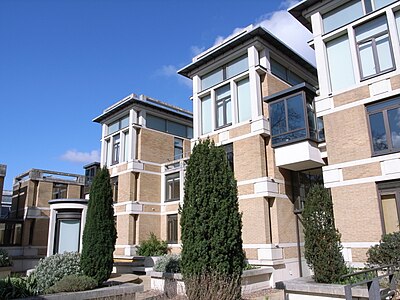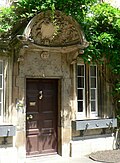Portal:University of Oxford
| Main page | Indices | Projects |
The University of Oxford portal
The University of Oxford is a collegiate research university in Oxford, England. There is evidence of teaching as early as 1096, making it the oldest university in the English-speaking world and the world's second-oldest university in continuous operation. It grew rapidly from 1167, when Henry II banned English students from attending the University of Paris. After disputes between students and Oxford townsfolk in 1209, some academics fled north-east to Cambridge where they established what became the University of Cambridge. The two English ancient universities share many common features and are jointly referred to as Oxbridge.
The University of Oxford is made up of thirty-nine semi-autonomous constituent colleges, four permanent private halls, and a range of academic departments which are organised into four divisions. Each college is a self-governing institution within the university, controlling its own membership and having its own internal structure and activities. All students are members of a college.
It does not have a main campus, but its buildings and facilities are scattered throughout the city centre. Undergraduate teaching at Oxford consists of lectures, small-group tutorials at the colleges and halls, seminars, laboratory work and occasionally further tutorials provided by the central university faculties and departments. Postgraduate teaching is provided in a predominantly centralised fashion.
Oxford operates the Ashmolean Museum, the world's oldest university museum; Oxford University Press, the largest university press in the world; and the largest academic library system nationwide. In the fiscal year ending 31 July 2023, the university had a total consolidated income of £2.92 billion, of which £789 million was from research grants and contracts.
Oxford has educated a wide range of notable alumni, including 30 prime ministers of the United Kingdom and many heads of state and government around the world. 73 Nobel Prize laureates, 4 Fields Medalists, and 6 Turing Award winners have matriculated, worked, or held visiting fellowships at the University of Oxford, while its alumni have won 160 Olympic medals. Oxford is the home of numerous scholarships, including the Rhodes Scholarship, one of the oldest international graduate scholarship programmes. (Full article...)
Selected article
The Principal and Fellows of Jesus College form the college's governing body. The Principal must be "a person distinguished for literary or scientific attainments, or for services in the work of education in the University or elsewhere", and has "pre-eminence and authority over all members of the College and all persons connected therewith". The Principal's Lodgings (entrance pictured) are in the first quadrangle of the college. The current Principal, Lord Krebs, was appointed in 2005 and is the 30th holder of the office. Professorial Fellows are those Professors and Readers of the university who are allocated to the college. One of these professorships is the Jesus Professor of Celtic, which is the only chair in Celtic studies at an English university. Official Fellows are those who hold tutorial or administrative appointments in the college. Past Official Fellows include the composer and musicologist John Caldwell, the historians Sir Goronwy Edwards and Niall Ferguson, the philosopher Galen Strawson and the political philosopher John Gray. There are also Senior and Junior Research Fellows. Principals and Fellows who retire can be elected as Emeritus Fellows. The college can also elect "distinguished persons" to Honorary Fellowships. (Full article...)
Selected biography
Selected college or hall
Wadham College, in the centre of the city on Parks Road, was founded in 1610 by Dorothy Wadham, using money that her husband Nicholas had bequeathed for the establishment of an Oxford college. The main quadrangle was designed by William Arnold and constructed between 1610 and 1613, and includes a statue of King James I (in whose reign the college was founded). The hall, one of the largest in Oxford, has a hammer-beam roof and Jacobean woodwork. The grounds include large gardens, the Holywell Music Room, dating from 1748, and more modern buildings used for accommodation and teaching. The original rules that no women were to enter the premises apart from a laundress who was "above suspicion" were gradually relaxed, and women were admitted as students in 1974. The college traditionally has a left-wing ethos. Alumni include the conductor Thomas Beecham, the poet Cecil Day-Lewis, the politician Michael Foot and Rowan Williams, formerly Archbishop of Canterbury. (Full article...)
Selected image

Did you know
Articles from Wikipedia's "Did You Know" archives about the university and people associated with it:
- ... that after Evelyn Waugh (pictured) brought a priest to anoint lapsed Catholic Hubert Duggan on his deathbed, Duggan was reconciled to the church, an event Waugh fictionalised in Brideshead Revisited?
- ... that for helping endow a professorship of botany at Oxford, James Sherard was granted a doctorate in medicine by the university in 1731?
- ... that British journalist and Liberal politician Colin Coote was an editor of the The Daily Telegraph for 14 years?
- ... that Sir Ian Anstruther, 8th Baronet, held two separate baronetcies which on his death went to different sons?
- ... that George Hargreaves, Christian Party candidate in the 2008 Haltemprice and Howden by-election, has said that the dragon symbol on the Welsh flag is "nothing less than the sign of Satan"?
Selected quotation
Selected panorama
Wikimedia
The following Wikimedia Foundation sister projects provide more on this subject:
-
Commons
Free media repository -
Wikibooks
Free textbooks and manuals -
Wikidata
Free knowledge base -
Wikinews
Free-content news -
Wikiquote
Collection of quotations -
Wikisource
Free-content library -
Wikiversity
Free learning tools -
Wikivoyage
Free travel guide -
Wiktionary
Dictionary and thesaurus















